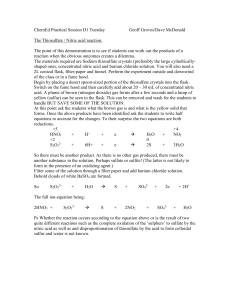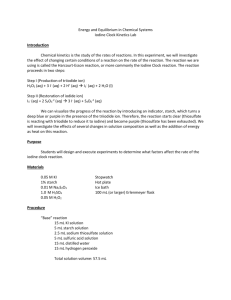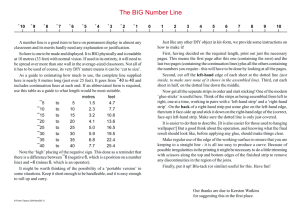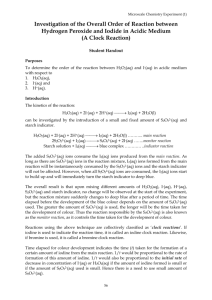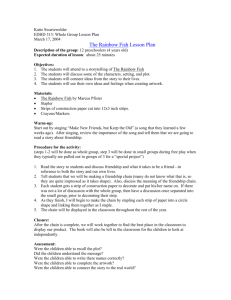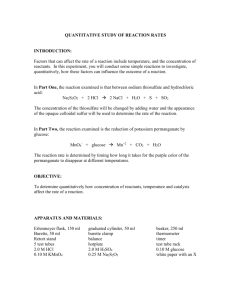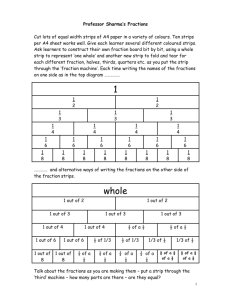Kinetic Study of Thiosulfate in Acid
advertisement
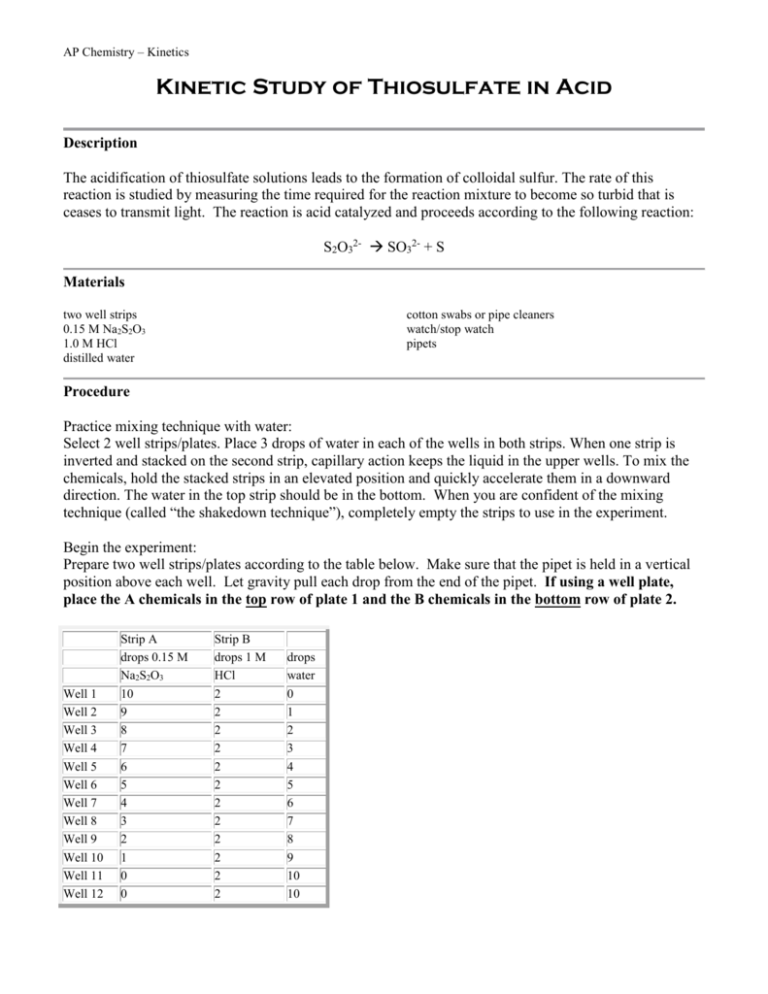
AP Chemistry – Kinetics Kinetic Study of Thiosulfate in Acid Description The acidification of thiosulfate solutions leads to the formation of colloidal sulfur. The rate of this reaction is studied by measuring the time required for the reaction mixture to become so turbid that is ceases to transmit light. The reaction is acid catalyzed and proceeds according to the following reaction: S2O32- SO32- + S Materials two well strips 0.15 M Na2S2O3 1.0 M HCl distilled water cotton swabs or pipe cleaners watch/stop watch pipets Procedure Practice mixing technique with water: Select 2 well strips/plates. Place 3 drops of water in each of the wells in both strips. When one strip is inverted and stacked on the second strip, capillary action keeps the liquid in the upper wells. To mix the chemicals, hold the stacked strips in an elevated position and quickly accelerate them in a downward direction. The water in the top strip should be in the bottom. When you are confident of the mixing technique (called “the shakedown technique”), completely empty the strips to use in the experiment. Begin the experiment: Prepare two well strips/plates according to the table below. Make sure that the pipet is held in a vertical position above each well. Let gravity pull each drop from the end of the pipet. If using a well plate, place the A chemicals in the top row of plate 1 and the B chemicals in the bottom row of plate 2. Well 1 Well 2 Well 3 Well 4 Well 5 Well 6 Well 7 Well 8 Well 9 Well 10 Well 11 Well 12 Strip A drops 0.15 M Na2S2O3 10 9 8 7 6 5 4 3 2 1 0 0 Strip B drops 1 M HCl 2 2 2 2 2 2 2 2 2 2 2 2 drops water 0 1 2 3 4 5 6 7 8 9 10 10 AP Chemistry – Kinetics When one strip is inverted and stacked on the second strip, capillary action keeps the liquid in the upper wells. Work with a partner. One partner mixes the chemicals with the shakedown technique. Your partner needs to begin timing now! Place the bottom strip over a line of text on this page. The other partner observes, notes, and records times. Mix the chemicals and note the time to the nearest second. Note the time at which the words disappear (i.e., are no longer visible) through the top of the well. Record the time for all wells. Clean the strip immediately after the last well changes or the experiment is ended. Scrub the wells with a cotton swab or pipe cleaner. Repeat three times and average the results: Trial 1 Trial 2 Trial 3 Average time(s) time (s) time (s) time (s) Well 1 Well 2 Well 3 Well 4 Well 5 Well 6 Well 7 Well 8 Well 9 Well 10 Well 11 Well 12 Questions 1. Prepare two graphs of your results. On one graph plot time on the y-axis and drops of thiosulfate on the x-axis. On the second graph plot the reciprocal of the time (1/time) on the y-axis and drops of thiosulfate on the x-axis. Use graph paper! 2. What is the order of this reaction with respect to the thiosulfate concentration: HINT: If the second graph has a slope of zero the reaction is zero order with respect to thiosulfate. If the second graph is a straight line with a non-zero slope the reaction is first order with respect to thiosulfate. If the second graph is parabolic the reaction is second order with respect to thiosulfate. 3. Write the rate law for this reaction. AP Chemistry – Kinetics Teachers’ Guide Background The rate of reaction can be represented by the following equation: Rate = k[S2O32-]a[H+]b The concentration of H+ is held constant in the procedure; all wells in strip B were filled with the same amount of acid. We may write the rate: Rate = k'[S2O32-]a Where [H+]b has been absorbed into the pseudo-rate constant, k'. In each reaction well we wait until the character is no longer visible. Presumably this requires that the same amount of sulfur be produced. The amounts of reactant used up in causing this to take place are small, so the reactant concentrations remain essentially constant throughout the time of reaction. The expression for rate is: [S2O32-] time But the amount of thiosulfate used up at the time of the endpoint is a constant because the amount (moles) of sulfur is constant for each well. Therefore, the rate is related to a constant divided by the time it takes to reach the end point. Plotting (1/time) is the same as plotting a constant times the reaction rate. But the rate is equal to k'[S2O32-]a. Therefore, a plot of the rate versus [S2O32-] gives an indication of the exponent, a. If the slope is zero, a = 0. If there is a straight line through the origin, a = 1. If there is a parabola, a = 2. TG Data Table drops Na2S2O3 time (sec) Well 1 10 30 Well 2 9 32 Well 3 8 37 Well 4 7 42 Well 5 6 50 Well 6 5 60 Well 7 4 78 On the same graph plot the reciprocal of the time as the y-axis. If the second graph has zero slope, the order is zero. If the graph is linear with slope of 1 and passes through the origin, the order is one. If the curve is parabolic, the order is two. AP Chemistry – Kinetics Determine the order of thiosulfate in the reaction. All of the solutions used may be safely discarded at the sink. The test tube and one 12-well strip may need to be brushed to remove sulfur deposits.
